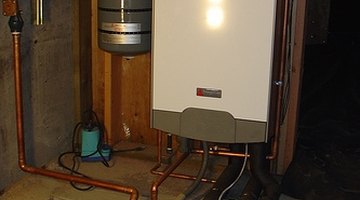How to Bleed Hot Water Heating Systems
Hot water heating systems have been around for a long time and are an efficient way for homeowners to keep warm during the long winter months. Many people find that the radiant heat generated by hot water systems to be more comfortable and pleasant than the warmth provided by forced air heat.

However, like any other appliance, these heating systems can sometimes experience problems. Before you call a plumber, try these steps to see if you can get your system working again.
Things You Will Need
- Rags or old cloths
- Work gloves
- Safety goggles
- Bowl or newspapers
-
Allow the heating system to run for an hour or so in order to circulate the water.
-
Switch off the heating system.
-
Locate the bleed valve on the main system tank. This is usually near the bottom. It may look like a standard hose outlet with threading on the edge.
-
Cover the bleed opening with the piece of old cloth. This will be used to catch any excess water coming out of the bleed valve. The water will be hot, so you may want to protect your hands with a pair of gloves and cover your eyes with safety glasses. If your boiler is located in a spot that has flooring you would like to protect, place the bowl or newspapers beneath the valve to soak up any water you miss with the rags.
-
Open the bleed valve slowly. You should hear a hissing sound as air is pushed out of the system. Take caution as this air could be very hot.
-
When water starts to come out the valve, turn the handle to close it.
-
On some systems, you will need to add more water after a bleeding procedure. In general, most boilers need slightly more than one bar of pressure when they are not operating, but some may require more. The usual procedure to re-pressurize the systm is to open the valve on the water supply line until you see the gauge on the boiler go over the required minimum pressure.
-
Restart the system. Check around the boiler for leaks.
Tip
It's best to do any kind of boiler maintenance during the summer or fall months. This will give you time to make any necessary repairs before winter.
Warning
Consult any manuals or instructions that came with your specific boiler model for pressure settings and other important information.
Be careful not to over-tighten the bleeder knob as this could damage it, causing leakage.
The Drip Cap
- Hot water heating systems have been around for a long time and are an efficient way for homeowners to keep warm during the long winter months.
- Locate the bleed valve on the main system tank.
- This is usually near the bottom.
- The usual procedure to re-pressurize the systm is to open the valve on the water supply line until you see the gauge on the boiler go over the required minimum pressure.
- Check around the boiler for leaks.
References
Resources
Writer Bio
Nathan McGinty started writing in 1995. He has a Bachelor of Science in communications from the University of Texas at Austin and a Master of Arts in international journalism from City University, London. He has worked in the technology industry for more than 20 years, in positions ranging from tech support to marketing.
Photo Credits
- The Lebers: Flickr.com
- The Lebers: Flickr.com
More Articles



